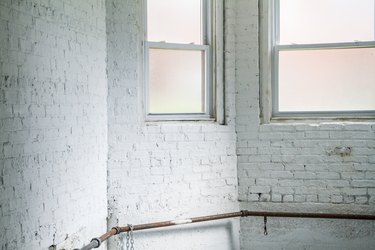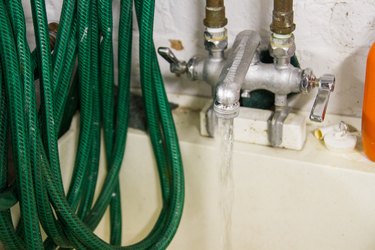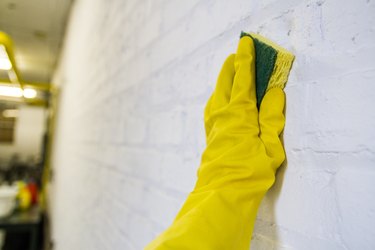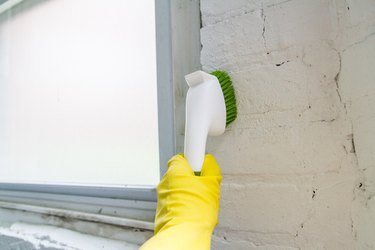
The darkness and humidity in the basement provide ideal conditions for mold, and it usually doesn't take a microscope to tell you have a problem; your eyes and nose are suitable tools. Concrete walls are not especially prone to mold and mildew -- which are words for the same thing. But even an inorganic material like concrete can become mildewed when spores begin to grow on dust, dirt or old paint on its surface. The recommended way to clean mold off concrete is to scrub it with detergent and water.
Reasons to Avoid Bleach
Video of the Day

For many years, bleach was the go-to cleaner for mold, and many commercial mold cleaning products still include it as the main ingredient. There are good reasons to avoid bleach, though . The first is that it probably won't work; it has a high surface tension that prevents it from penetrating into the pores of concrete and killing spores. Even the Clorox Co., which manufactures household bleach, recommends its use only on non-porous surfaces, such as porcelain or ceramic. The second reason to avoid it is that bleach is corrosive and can damage the concrete. If you opt for bleach, dilute each part with 4 parts water.
Video of the Day
Apply Detergent and Water

The U.S. Environmental Protection Agency recommends cleaning mold with detergent and water. It doesn't specify the concentration of detergent, so start by mixing 1/4 cup of laundry detergent per gallon of water and add more detergent if needed. You can deep clean your concrete by using trisodium phosphate, which is a strong detergent that can degrease as it removes mold and dirt. Mix 1/4 to 1/2 cup of TSP per gallon of warm water, and wear rubber gloves and goggles while scrubbing with it. If the mold is powdery, you should also wear a mask to avoid inhaling spores.
Scrub Thoroughly, Then Disinfect

The bulk of mold remediation involves physically removing it from the concrete with a scrub brush. Use a brush with stiff fiber bristles -- not a wire brush -- and scrub until all the discoloration has been removed. Once all the mold is gone, you may want to use a dilute bleach solution to disinfect. But vinegar also disinfects, and it penetrates concrete better than bleach. Spray the walls with a 1-to-1 solution of vinegar and water and allow the vinegar to dry. It doesn't hurt to scrub after spraying to help with penetration.
Preventing Mold

As long as your concrete walls remain moist, mold is likely to return. If the moisture is caused by drainage issues, consider installing a French drain around the perimeter of your house to divert water. If water isn't actively seeping through, sealing the concrete with epoxy can also help to dry things out. Raising the temperature in the basement also helps control humidity. Dust the walls with borax or add borax to the vinegar spray when you disinfect. Borax repels mold, and leaving a thin layer of it on the concrete is an effective way to prevent mold from growing.